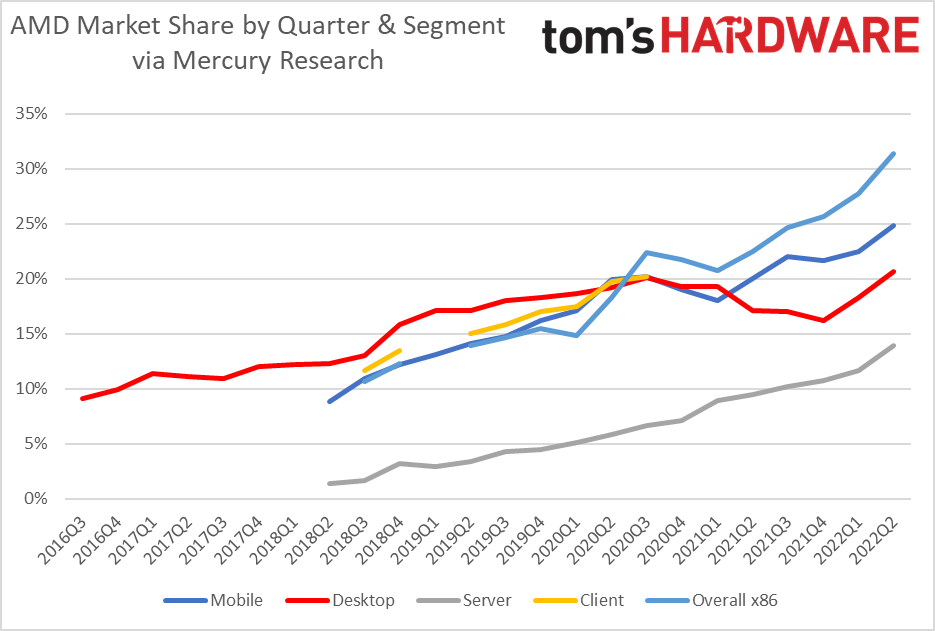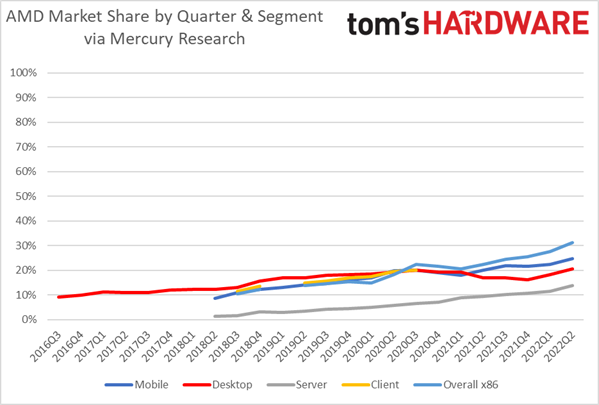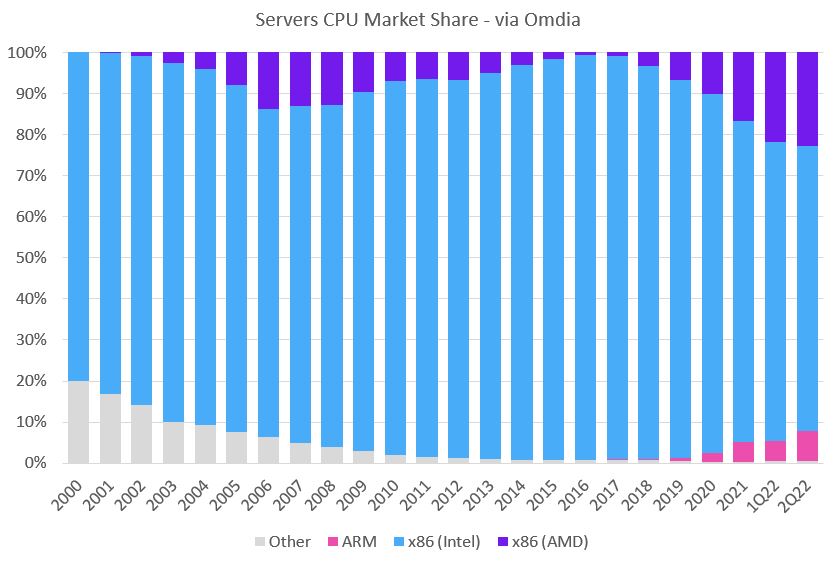Desktop CPU Sales Lowest in 30 Years, AMD Gains Market Share Anyway (Updated)
One rises while the rest fall.


The Mercury Research CPU market share results are in for the second quarter of 2022, and the news isn't great — desktop CPU shipments dropped to their lowest level in nearly three decades. Dean McCarron from Mercury Research says the year-over-year decline is the largest in the firm's records, which stretches back 28 years, and predicts it was the biggest since 1984 (36 years). The decline came as OEMs reduced their inventory, drastically reducing demand in the quarter. Somehow AMD managed to carve out gains in both unit share and revenue during the quarter, though.
According to the recent earnings report from Intel, AMD, and Nvidia, the recovery will be a long one. Intel issued a dire earnings report last week — the company lost money for the first time in decades, partially driven by PC declines. Intel also announced it was delaying its critical Xeon Sapphire Rapids data center chips and killing off another failing business unit, Optane; the sixth unit retired since new CEO Pat Gelsinger took over.
In contrast, AMD's revenue was up 70% year-over-year as the company continued to improve its already-great profitability. AMD is firing on all cylinders and will launch its Ryzen 7000 CPUs, RDNA 3 GPUs, and EPYC Genoa data center processors on schedule.
That consistent execution continues to pay off. AMD took big strides in the mobile/laptop market again, setting another record for unit share in that segment with 24.8%. AMD also gained in the server market for the 13th consecutive quarter, reaching 13.9% of the market. Notably, AMD's quarterly gain in servers is the largest we've seen in our historical data, which dates back to 2017, and it set a record for server revenue share. AMD also set a new record of 31.4% of the total market share for x86 processors.
It's safe to say that all signs point to a continued PC slump — Intel and AMD expect the desktop and notebook PC market to be down double-digits through the end of the year. Nvidia also announced that it had drastically underperformed its guide by $1.4 billion due to slumping gaming GPU sales, and its partners expect up to a 50% decline in GPU shipments this year. It's hard to gauge how much of that volume was actually destined for gaming PCs as opposed to cryptominers, so the tea leaves are murky.
Arm CPU market share reached 9.4%, a decline from 11.3% last quarter. McCarron says that much of this was due to Apple's sales of its M1 Macs being down last quarter, dragging down the overall share of Arm chips. However, Arm may have grown within the Chromebook segment. Apple encountered supply disruptions during the quarter due to lockdowns in China, impacting its ability to ship units and likely impacting its share gains against x86.
However, as you'll see below, Arm continues to drastically improve its market share in the server market.
You can find the raw numbers broken out segment by segment in the tables below.
- In desktop, AMD revenue share increased 0.7 share points year over year to 18.8%.
- In notebook, AMD revenue share increased 12.1 share points year over year to 27.0% -- an all-time high for AMD.
- In server, AMD revenue share increased 11.3 share points year over year to 22.9%.
- In overall x86, AMD revenue share increased 11.2 share points year over year to 28.1% -- an all-time high for AMD.
AMD vs. Intel Desktop PC Market Share Q2 2022
| Row 0 - Cell 0 | 2Q22 | 1Q22 | 4Q21 | 3Q21 | 2Q21 | 1Q21 | 4Q20 | 3Q20 | 2Q20 | 1Q20 | 4Q19 | 3Q19 | 2Q19 | 1Q2019 | 4Q18 | 3Q18 | 2Q18 | 1Q18 | 4Q17 | 3Q17 | 2Q17 | 1Q17 | 4Q16 | 3Q16 |
| AMD Desktop Unit Share | 20.6% | 18.3% | 16.2% | 17.0% | 17.1% | 19.3% | 19.3% | 20.1% | 19.2% | 18.6% | 18.3% | 18% | 17.1% | 17.1% | 15.8% | 13% | 12.3% | 12.2% | 12.0% | 10.9% | 11.1% | 11.4% | 9.9% | 9.1% |
| Quarter over Quarter / Year over Year (pp) | +2.3% / +3.5% | +2.1 / -1.0 | -0.8 / -3.1 | -0.1 / -3.1 | -2.3 / -2.1 | +0.1 / +0.7 | -0.8 / +1.0 | +0.9 / +2.1 | +0.6 / +2.1 | +0.3 / +1.5 | +0.3 / +2.4 | +0.9 / +5 | Flat / +4.8 | +1.3 / +4.9 | +2.8 / +3.8 | +0.7 / +2.1 | +0.1 / +1.2 | +0.2 / +0.8 | +1.1 / +2.1 | -0.2 / +1.8 | -0.3 / - | +1.5 / - | +0.8 / - | - |
The decline in the PC market began as the pandemic receded and global economic turmoil and inflation mounted. AMD continues its streak of market share gains, reaching 20.6% of the unit share in the quarter.
"AMD's desktop business experienced a modest rebound from the declines of the first quarter, while Intel's desktop CPU shipments continued to decline. Intel appeared to be impacted by continued inventory corrections lowering shipments in the quarter; AMD's business showed no significant inventory impacts and share was gained," McCarron said.
Get Tom's Hardware's best news and in-depth reviews, straight to your inbox.
AMD vs. Intel Notebook / Mobile Market Share Q2 2022
| Row 0 - Cell 0 | 2Q22 | 1Q22 | 4Q21 | 3Q21 | 2Q21 | 1Q21 | 4Q20 | 3Q20 | 2Q20 | 1Q20 | Q419 | 3Q19 | 2Q19 | 1Q2019 | 4Q18 | 3Q18 | 2Q18 |
| AMD Mobile Unit Share | 24.8% | 22.5% | 21.6% | 22.0% | 20.0% | 18.0% | 19% | 20.2% | 19.9% | 17.1% | 16.2% | 14.7% | 14.1% | 13.1% | 12.2% | 10.9% | 8.8% |
| Quarter over Quarter / Year over Year (pp) | +2.3% / +4.8% | +0.9 / +4.4 | -0.4 / +2.6 | +2.0 / +1.8 | +1.9 / +0.01 | -1.0 / +1.1 | -1.2 / +2.8 | +0.3 / +5.5 | +2.9 / +5.8 | +0.9 / +3.2 | +1.5 / +4.0 | +0.7 / +3.8 | +1.0 / +5.3 | +0.9 / ? | Row 2 - Cell 15 | Row 2 - Cell 16 | Row 2 - Cell 17 |
AMD set yet another market share record in the notebook market, an impressive feat given that it doesn't sell as many chips into the low-end segment as Intel. This marks yet another market share record for AMD in the mobile space.
"While AMD had slight growth in mobile CPU shipments in the second quarter, it was well below normal levels and both AMD and Intel had significant on-year declines in mobile CPU units shipped; both suppliers appear to be coping with a downturn in CPU demand, though Intel was disproportionately affected and lost share to AMD as a result," said McCarron.
AMD vs. Intel Server Unit Market Share Q2 2022
| Row 0 - Cell 0 | 2Q22 | 1Q22 | 4Q21 | 3Q21 | 2Q21 | 1Q21 | 4Q20 | 3Q20 | 2Q20 | 1Q20 | 4Q19 | 3Q19 | 2Q19 | 1Q2019 | 4Q18 | 3Q18 | 2Q18 | 4Q17 |
| AMD Server Unit Share | 13.9% | 11.6% | 10.7% | 10.2% | 9.5% | 8.9% | 7.1% | 6.6% | 5.8% | 5.1% | 4.5% | 4.3% | 3.4% | 2.9% | 3.2% | 1.6% | 1.4% | 0.8% |
| Quarter over Quarter / Year over Year (pp) | +2.3% / +4.4% | +0.9 / +2.7 | +0.5% / +3.6 | +0.7 / +3.6 | +0.6 / +3.7 | +1.8 / +3.8 | +0.5 / +2.6 | +0.8 / +2.3 | +0.7 / +2.4 | +0.6 / 2.2 | +0.2 / +1.4 | +0.9 / +2.7 | +0.5 / +2.0 | -0.3 / - | +1.6 / 2.4 | +0.2 / - | Row 2 - Cell 17 | Row 2 - Cell 18 |
AMD bases its server share projections on IDC's forecasts but only accounts for the single- and dual-socket market, which eliminates four-socket (and beyond) servers, networking infrastructure, and Xeon D's (edge). As such, Mercury's numbers differ from the numbers cited by AMD, which predicts a higher market share. Here is AMD's comment on the matter: "Mercury Research captures all x86 server-class processors in their server unit estimate, regardless of device (server, network or storage), whereas the estimated 1P [single-socket] and 2P [two-socket] TAM [Total Addressable Market] provided by IDC only includes traditional servers."
AMD continued its three-year streak of quarterly share gains and made the largest single quarterly gain as far back as our records go (2017). AMD gained in the server market for the 13th consecutive quarter, reaching 13.9% of the market. AMD set both shipment and revenue records in the quarter.
Intel continues to suffer in this segment, and it also announced its Sapphire Rapids will be delayed yet again. The company hasn't set a discernable date for the full launch, but we expect that to come in Q1 next year.
Arm vs. x86 Server Market Share Q2 2022

| Row 0 - Cell 0 | 2Q22 | 1Q22 | 4Q21 | 3Q21 | 2Q21 | 1Q21 | 2020 | 2019 | 2018 | 2017 | 2016 |
| Intel | 69.5% | 72.7% | 76% | 76.7% | 79.7% | 80.3% | 87.4% | 92.1% | 95.7% | 98.2% | 98.6% |
| AMD | 22.7% | 21.8% | 18.3% | 18.2% | 15.9% | 14.5% | 10.1% | 6.7% | 3.3% | 0.9% | 0.5% |
| Arm | 7.1% | 4.9% | 5.4% | 4.9% | 4.1% | 4.8% | 2.2% | 0.7% | 0.3% | 0.2% | 0.1% |
This information comes from research firm Omdia, which uses different measurement methodologies. It also gives us more insight into Arm's penetration into the data center. Omdia has shared this early information for the quarter with us, with the caveat that the firm is still cross-checking its numbers versus inventory burn in the second quarter and comparing CPU vs. server shipments and purchases. As such, there might be slight adjustments in the final tally.
If you were wondering why Intel's margins for its server CPU business plummeted last quarter, here's the answer. As you can see, Intel is losing share rapidly over the last few quarters, with both Arm and AMD no longer nipping at its heels — they're now taking chunks.
Even though the Arm server share calculations are still preliminary, Vlad Galabov, Director at Omdia, Head of the Cloud and Data Center Research Practice, tells us that AWS, Huawei, and Ampere are gaining share rapidly in the market.
Server shipments weighed in at 3.4 million for the quarter. Omdia measures Intel at 69.5% of the data center market, AMD at 22.7%, and Arm at a record 7.1%. (0.6% goes to 'other.') Notably, ARM's share has increased 48% year-over-year.
Arm vs x86 Consumer Market Share Q2 2022
| Arm vs x86 Market Share | 2Q22 | 1Q22 | 4Q21 | 3Q21 | 2Q21 | 1Q21 | 4Q20 | 2Q20 |
| Arm Unit Share | 9.5% | 11.3% | 10.3% | 8.3% | ~7.0% | 5.9% | 3.4% | Less than 2% |
"Our estimate for ARM CPU PC client share (including Chromebooks and Apple's M1 based Macs with X86 desktop and mobile CPUs in the total client size estimate) is 9.4 percent, down from 11.3 percent last quarter and up from 7.7 percent a year ago. Apple's Mac business was down significantly on quarter, which dragged ARM share down. We noted that within the Chromebook market it appeared that ARM's share may have increased slightly in the quarter," said McCarron.
AMD vs. Intel Overall x86 Market Share Q2 2022
| Row 0 - Cell 0 | 2Q22 | 1Q22 | 4Q21 | 3Q21 | 2Q21 | 1Q21 | 4Q20 | 3Q20 | 2Q20 | 1Q20 | 4Q19 | 3Q19 | 2Q19 | 4Q18 | 3Q18 |
| AMD Overall x86 | 31.4% | 27.7% | 25.6% | 24.6% | 22.5% | 20.7% | 21.7% | 22.4% | 18.3% | 14.8% | 15.1% | 14.6% | 13.9% | 12.3% | 10.6% |
| Overall PP Change QoQ / YoY | +3.7 / +8.9 | +2.1 / +7.0 | +1.0 / +3.9 | +2.1 / +2.2 | +1.8 / +4.2 | -1.0 / +6.0 | -0.7 / +6.2 | +4.1 / +6.6 | +3.5 / +1.2 (+3.7?) | -0.7 / ? | +0.9 / +3.2 | +0.7 / +4 | ? | ? | - |
Whereas the other segments above exclude IoT and semi-custom units (like AMD's game console business), this accounting of the overall x86 market also includes those products.
AMD has gained an incredible 8.9 percentage points year-over-year and 3.7 points over the prior quarter, setting yet another new record.

Paul Alcorn is the Editor-in-Chief for Tom's Hardware US. He also writes news and reviews on CPUs, storage, and enterprise hardware.
-
escksu This trend is to be expected. COVID causes unusually high volume (as many rushed to buy PC/laptops). Of course few would be buying right now.Reply -
Co BIY I'm surprised the increase in desktop wasn't more but maybe many sales of AMD chips are replacing earlier chips on the same board.Reply -
Jimbojan I am sorry, I cannot see any reason AMD's desktop or notebook can gain market share as Intel's similar parts have better performance and lower price, you and most evaluators said so. Intel's server may be lagging mainly because Sapphire Rapids is delayed. I can believe it. Is there something wrong here or a scam by AMD?Reply -
JWNoctis Reply
Feel free to bring up statistics that says otherwise.Jimbojan said:I am sorry, I cannot see any reason AMD's desktop or notebook can gain market share as Intel's similar parts have better performance and lower price, you and most evaluators said so. Intel's server may be lagging mainly because Sapphire Rapids is delayed. I can believe it. Is there something wrong here or a scam by AMD?
To be fair, in mobile space at least, Intel did not really catch up to Zen 3 APU offerings with their mobile processors until 12th-gen. Their 11th-gen had somewhat superior IPC but ran too hot, while 10th-gen, their common offering when Zen 3 came out, was significantly weaker. Also, mobile AMD processors - unlike mobile AMD GPU - was not unobtainium. You can't gain market share if you can't supply the market.
Then again, if performance is all that the market is after, AMD would have been killed by FX series (to be fair, they almost were), if Intel had not been killed by the hot mess that was NetBurst first. -
Ogotai Reply
well, if you can provide links that show and prove other wise, then by all means.Jimbojan said:I am sorry, I cannot see any reason AMD's desktop or notebook can gain market share as Intel's similar parts have better performance and lower price, you and most evaluators said so. Intel's server may be lagging mainly because Sapphire Rapids is delayed. I can believe it. Is there something wrong here or a scam by AMD? -
Johnpombrio AMD has done a remarkable job in both servers and laptops. I expect that Intel will figure out a way to chop this down somewhat but all credit to AMD for its sucesses.Reply -
Sleepy_Hollowed This sounds about right.Reply
I replaced a 2600 CPU from Intel with AMD due to power/performance ratio + cooling requirements (which all add up to PSU power and total system power).
Unless AMD breaks something on their roadmap or Intel happens to destroy them in those, might happen again as well, though that nasty AMD CPU vulnerability might throw a curveball if the fix takes too much performance out. -
Kamen Rider Blade Time for AMD to continue Steam Rolling Intel and making them bleed like a wounded animal.Reply